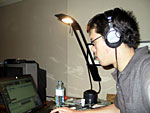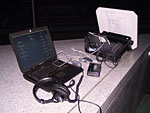By Michael Khoo
Minnesota Public Radio
June 12, 2002
SATELLITE TIME
The stories I produce for All Things Considered and that appear on this Web site and fed in studio-quality sound. This is no small accomplishment when the nearest MPR studio is thousands of miles away. The secret is in the satellite.
| |
|
|
|
||
This picture is a shot of me in my hotel room producing a story on the laptop (say, what's happened to my hair, anyway?). This laptop is pretty amazing: a portable version of the same equipment found in MPR's production booths back in St. Paul.
Once the story is produced, I hook the same laptop up to a portable satellite terminal (shown), and beam it back home via satellite. Sending a four minute story takes about eight minutes of satellite time. The setup you see here, while a little cumbersome, turns me or anyone into a walking radio station (and is part of the reason I raised the eyebrows of the Chinese customs officials). So that Al Franken sketch you might remember from Saturday Night Live all the sudden doesn't seem so funny.
The only drawback is that the satellite telephone must have direct line of sight with the target satellite.
| |
|
|
|
||
My hotel room window in Beijing was blocked by a neighboring building, so I had to drag the entire setup outside - to the street. One night while sending a story back at 1 a.m., I suddenly felt some standing behind me. Turning around, I was face to face with a policeman who was taking an awfully keen interest in my suspicious equipment. We stood only a foot or two apart exchanging glances for several minutes. He was so close I wasn't sure if he'd arrest me or kiss me.
Trying to keep cool, I asked him if he spoke English. He said he didn't and moments later left me in peace. But it wasn't before long that another policeman approached who did speak English after a fashion. He said, "What can I do for you?"
I said, "What?" when what I really wanted to say was, "Here's what you can do for me: go away for 10 minutes and then come back," by which time I'll have finished and have been long gone from the scene. He repeated himself.
I finally looked at him and back at my satellite phone. "It's a telephone," I said.
"Oh, telephone."
"Yes."
"Oh, telephone." Then he walked away, as if to say, "Is that all it is? Well, why didn't you just say so in the first place?"
Now that, I thought, was an authentic Beijing street scene.
One other word about satellite phones. Pioneer Press photographer Rich Marshall also brought a smaller satellite phone to transmit digital pictures back to his newsroom. At lunch the other day, Rich leaned over to me and said, "I never thought I'd ask a question like this, but what satellite do you aim for?" I guess that makes us geeks or something.
THE ANSWER
For those who care: the Indian Ocean Region (IOR) satellite, part of the Inmarsat Global Area Network.
THE GOOD NEWS
My hotel room in Shanghai faces almost directly the IOR satellite. So now I don't have to leave my room to feed stories.


